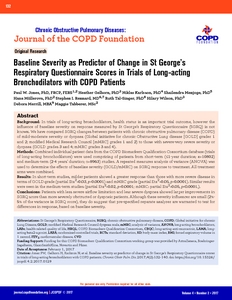Jones, PW; Gelhorn, H; Karlsson, N; Menjoge, S; Müllerova, H; Rennard, SI; Tal-Singer, R; Wilson, H; Merrill, D; Tabberer, M
(2017)
Baseline Severity as Predictor of Change in St George's Respiratory Questionnaire Scores in Trials of Long-acting Bronchodilators with COPD Patients.
Chronic Obstr Pulm Dis, 4 (2).
pp. 132-140.
ISSN 2372-952X
https://doi.org/10.15326/jcopdf.4.2.2017.0129
SGUL Authors: Jones, Paul Wyatt
![[img]](https://openaccess.sgul.ac.uk/109130/1.hassmallThumbnailVersion/JCOPDF-2017-0129-Jones2.pdf)  Preview |
|
PDF
Published Version
Available under License ["licenses_description_publisher" not defined].
Download (2MB)
| Preview
|
Abstract
Background: In trials oflong-acting bronchodilators, health status is an important trial outcome, however the influence of baseline severity on response measured by St George's Respiratory Questionnaire (SGRQ) is not known. We have compared SGRQ changes between patients with chronic obstructive pulmonary disease (COPD) of mild-moderate severity or dyspnea (Global initiative for chronic Obstructive Lung disease [GOLD] grades 1 and 2; modified Medical Research Council [mMRC] grades 1 and 2) to those with severe-very severe severity or dyspnea (GOLD grades 3 and 4; mMRC grades 3 and 4). Methods: Combined individual patient data from the COPD Biomarkers Qualification Consortium database (trials of long-acting bronchodilators) were used comprising of patients from short-term (≤1-year duration; n=10802) and medium-term (2-4 years' duration; n=8963) studies. A repeated measures analysis of variance (ANOVA) was used to determine the effects of baseline severity (GOLD/mMRC) on SGRQ response to treatment. All treatment arms were combined. Results: In short-term studies, milder patients showed a greater response than those with more severe disease in terms of GOLD grade (partial Eta(2) = 0.03, p < 0.0001) and mMRC grade (partial Eta(2) = 0.05, p < 0.0001). Similar results were seen in the medium-term studies (partial Eta(2) = 0.02, p < 0.0001; mMRC: partial Eta(2) = 0.05, p < 0.0001,). Conclusions: Patients with less severe airflow limitation and less severe dyspnea showed larger improvements in SGRQ score than more severely obstructed or dyspneic patients. Although these severity influences are small (2%-5% of the variance in SGRQ score), they do suggest that pre-specified separate analyses are warranted to test for differences in response, based on baseline severity.
Statistics
Item downloaded times since 14 Sep 2017.
Actions (login required)
 |
Edit Item |



